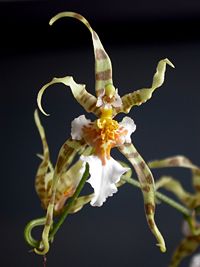Phymatochilum
| Phymatochilum | ||||||||||||||||||||
|---|---|---|---|---|---|---|---|---|---|---|---|---|---|---|---|---|---|---|---|---|
 | ||||||||||||||||||||
| Scientific classification | ||||||||||||||||||||
| ||||||||||||||||||||
| Type species | ||||||||||||||||||||
| Oncidium phymatochilum Lindl. 1848 | ||||||||||||||||||||
| Species | ||||||||||||||||||||
| ||||||||||||||||||||
| Synonyms | ||||||||||||||||||||
|
Phymatochilum is an orchid genus formed by only one species, Phymatochilum brasiliense, inhabitant of Serra do Mar mountains in Brazilian southeast and northeast, which vegetatively resembles Oncidium species, however, is more closely related to the genus Miltonia.
Distribution and habit
Phymatochilum brasiliense is a comparatively large sympodial epiphyte species which inhabits high areas of the Atlantic Forest of Rio de Janeiro, São Paulo, Espírito Santo, Minas Gerais and Pernambuco States of Brazil,[1] particularly in the warmer areas around Serra do Mar chain of mountains, where it is somewhat rare. It grows under the shadow of trees, however, mostly near the jungles well ventilated clearances where it can get brighter light, between 600 and 1,300 meters of altitude in dryer areas. It ordinarily grows over the trees where the shade is not intense, on thick branches.[2]
Description
| Measures (mm) | ||
| Structure | Lenght | Width |
| Rhizome | 15 | 15 |
| Leaf | 500 | 100 |
| Pseudobulb | 100 | 70 |
| Inflorescence | 1800 | - |
| Flower | 50 | 25 |
| Sepal | 35 | 3 |
| Petal | 25 | 3 |
| Labellum | 18 | 12 |
Phymatochilum brasiliense blooms between from the end of summer to middle autumn and its sweet fragrant flowers last for about two weeks. There is no reference about their pollinators.
Taxonomic notes
For some unknown reason there is a number of original descriptions by John Lindley, of plants received from Loddiges, that record Mexico, instead of Brazil, as the country of origin of the plants. It is not known if this information came from Loddiges, whether they were later confusions at the herbarium or either if it was a mistake on transport records. Some of these mistakes, particularly when occurred with less noticeable plants as Pabstiella crenata are still been solved. Some of these descriptions yet have to be cleared. The description of Phymatochilum brasiliense was one of these mistakes. This species is not recorded in Mexico or Central America after this early records.[3] Anyway, in 1847, Lindley received two different plants one from Loddiges and another from reverend Clowes, from Liverpool, an orchid enthusiast Lindley homaged when describing Miltonia clowesii, and the following year he described it under the genus Oncidium as O. phymatochilum.[4]
This species, whose flowers are very similar to the ones of Oncidium was in fact considered a member of this genus until 2001 when, based on the results of their molecular analysis, it was moved by Norris Williams and Mark Chase to the genus Miltonia. On the transfer publication they claim that, despite the morphologic differences, the relationship is very close and, supposedly, they did not want to propose a new genus to subordinate one species only.[5] As this species shows a morphology that is closer to Oncidium species than to Miltonia, because of its small yellowish flowers and highly branched inflorescence, this result and following transfer was a great surprise to most taxonomists. Therefore, in 2005, Eric Christenson suggested a new genus and the name Phymatochilum brasiliense for it.[6] There is no consensus about the name to be generally accepted as yet.
Molecular analysis shows that Phymatochilum most closely related genus is Miltonia and then Aspasia, Brassia and Ada, which are the most important genera included in this that is one of the eight clades that form the subtribus Oncidiinae of tribus Cymbidieae.[7]
References
- ↑ Pabst, Guido & Dungs, Fritz (1978). Orchidaceae Brasilienses vol. 2 p. 195. Brucke-Verlag Kurt Schmersow, Hildesheim. ISBN 3871050107
- ↑ Baker, Charles O & Baker, Margaret L. (2006). Miltonia phymatochila in Orchid Species Culture Oncidium/Odontoglossum Alliance: 345, Timber Press. ISBN 9780881927757
- ↑ Govaerts, Rafaël et al: World Checklist of Orchidaceae. The Board of Trustees of the Royal Botanic Gardens, Kew. Published on Internet (Access in March 2009).
- ↑ Lindley, John (1848). Oncidium phymatochilum in Gardeners' Chronicle and Agricultural Gazette 1848: 139. England.
- ↑ Williams, Norris H. & Chase, Mark W. (2001). Miltonia phymatochila in Lindleyana 16: 284.
- ↑ Christenson, Eric A. (2005). Phymatochilum brasiliense in Richardiana 5: 195.
- ↑ Williams NH, Chase MW, Fulcher T, Whitten WM (2001). Molecular systematics of the Oncidiinae based on evidence from four DNA sequence regions: expanded circumscriptions of Cyrtochilum, Erycina, Otoglossum, and Trichocentrum and a new genus (Orchidaceae) in Lindleyana 16(2): 113-139.